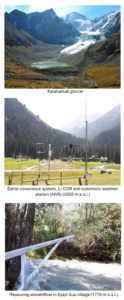 The Chon Kyzyl-Suu Observatory is managed by the Tien Shan High Mountain Scientific Centre of the National Academy of Sciences of the Kyrgyz Republic. Chon Kyzyl-Suu is the oldest CAMON observatory established in 1948 as a centre for research in physical geography of the Tien Shan. Located between Lake Issyk Kul and the northern slope of the Terskey Alatau (Teskey Ala-too), it has a long track record of hydro-meteorological, glaciological and biogeographical monitoring. Its domain extends from approximately 1600 m a.s.l. (Lake Issyk Kul) to 4000 m a.s.l. (glaciers). The observatory has premises in Kyzyl-Suu village (including a library and accommodation for staff and visiting researchers) and at the Lesnoy Cordon station (2571 m a.s.l.). The observatory hosts regular summer schools for early career researchers specialising in climate science, hydrology, glaciology, and ecology.
The Chon Kyzyl-Suu Observatory is managed by the Tien Shan High Mountain Scientific Centre of the National Academy of Sciences of the Kyrgyz Republic. Chon Kyzyl-Suu is the oldest CAMON observatory established in 1948 as a centre for research in physical geography of the Tien Shan. Located between Lake Issyk Kul and the northern slope of the Terskey Alatau (Teskey Ala-too), it has a long track record of hydro-meteorological, glaciological and biogeographical monitoring. Its domain extends from approximately 1600 m a.s.l. (Lake Issyk Kul) to 4000 m a.s.l. (glaciers). The observatory has premises in Kyzyl-Suu village (including a library and accommodation for staff and visiting researchers) and at the Lesnoy Cordon station (2571 m a.s.l.). The observatory hosts regular summer schools for early career researchers specialising in climate science, hydrology, glaciology, and ecology.
Chon Kyzyl-Suu monitors mass balance of the Kara-Batkak glacier (one of the World Glacier Monitoring Service reference glaciers) and two other glaciers (Sary-Tor and Bordu) located in the Ak-Shiyrak massif outside the observatory domain. It hosts both a conventional meteorological station (Lesnoy Cordon), five automatic weather stations (AWS), as well as three streamflow gauging sites. Li-COR measurements of evapotranspiration and CO2 are conducted and Hydroinnovia SnowFox sensor is used to measure Snow Water Equivalent (SWE). It runs continuous sampling of precipitation for isotopic analysis and participates in the CAMON isotope and hydrochemistry sampling programme collecting precipitation, river water and cryosphere samples.
Chon Kyzyl-Suu is known for its work on the reconstruction of palaeoenvironments using dendrochronology and palynology. For example, it provided tree-ring width data from Schrenk spruce (Picea schrenkiana) to reconstruct climatic oscillations in the Tien Shan since the middle of the 15th century (Wang et al., 2017). Currently, Chon Kyzyl-Suu is the only CAMON observatory monitoring biota on the long-term basis focusing on the ecology of Schrenk Spruce (Picea schrenkiana) and regeneration of forests.

